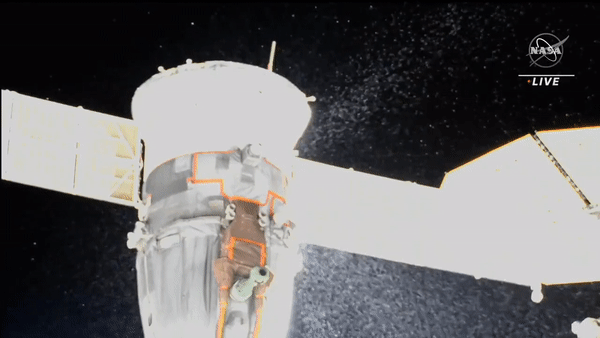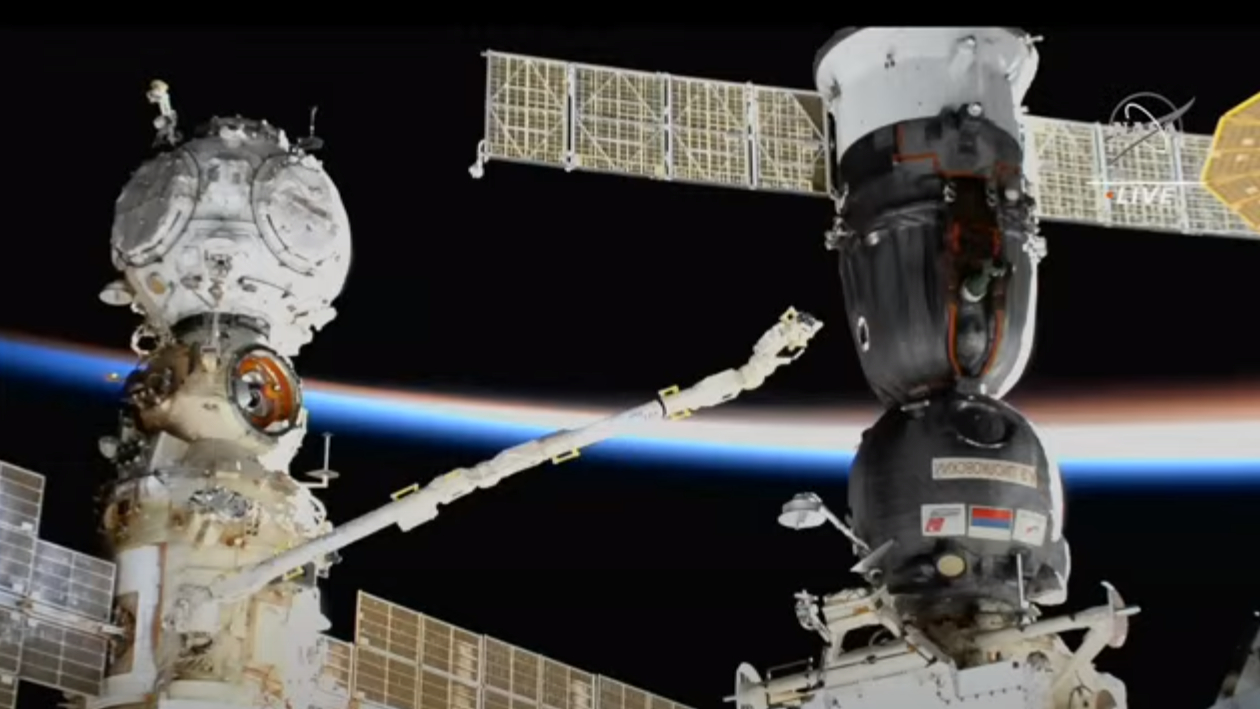Footage of the spectacular coolant leak from the Russian Soyuz spaceship that took place on Wednesday (Dec. 14) convinced a leading spaceflight safety expert that the craft is most likely no longer flightworthy. And that is a huge safety risk for the inhabitants of the International Space Station.
Tommaso Sgobba is the president of the International Association for the Advancement of Space Safety (IAASS) and a former head of spaceflight safety at the European Space Agency (ESA). Now formally retired, the veteran aerospace engineer who worked for years on Europe’s human spaceflight program spoke to Space.com about the Soyuz coolant leak. His conclusions are rather damning. The Soyuz spacecraft, Sgobba believes, is “damaged beyond repair” and will not be able to take the three space travelers it brought to the space station in September back home.
What is worse, for the first time in its history, the International Space Station (ISS) lacks the capability to evacuate all of its occupants in case of a serious incident.
“From what I saw from the pictures, this was a massive loss of coolant,” Sgobba told Space.com. “I have to assume that the active coolant system of the Soyuz spacecraft was compromised and therefore, the Soyuz is no longer available for operation. It’s my personal feeling, but if it’s true, we have a big problem on the space station. We are missing the crew escape system.”
Related: Soyuz capsule damaged by uncontrolled leak while at space station
No lifeboat for Soyuz crew
Russian cosmonauts Sergey Prokopyev and Dmitry Petelin and NASA astronaut Frank Rubio arrived at the ISS aboard the now-damaged Soyuz on Sept. 22 and are scheduled to return to Earth on March 28. Also on the station are NASA astronauts Nicole Mann and Josh Cassada, Japan’s Koichi Wakata and Russia’s Anna Kikina, who arrived aboard the SpaceX Crew Dragon in early October. That makes seven spacefarers.
But with the Soyuz most likely gone for good, only four people would be able to get to safety in the event that something goes wrong. This perilous situation might last weeks to months before a new spacecraft could be sent to the space station, according to Sgobba.
“This would most probably be the first time that the space station has no full lifeboat capability,” Sgobba said. “The only thing that can be done is for Russia to send a replacement Soyuz but that is not something that happens from one day to another. We should assume that there will be a period of weeks or maybe months in which this lack of [rescue] capability on the space station will be a matter of life.”
Tommaso Sgobba is the Executive Director and Board Secretary of the International Association for the Advancement of Space Safety and former Head of spaceflight safety at the European Space Agency (ESA). Now formally retired, Sgobba joined ESA in 1989 and worked as a product assurance and safety manager for all European manned missions on the space shuttle, MIR station, and for the European research facilities for the International Space Station. In 2004, he received a NASA recognition award for outstanding contribution to the International Space Station and in 2007 the prestigious NASA Space Flight Awareness (SFA) Award.
Rescue mission
So what exactly would the rescue operation look like? Sgobba believes that Russia would most likely send two Soyuz spacecraft to the orbital outpost at the same time. The two spaceships together would bring a new three-member crew.
One of these Soyuz capsules would then depart with the currently stranded team, while the second would remain at the station as a lifeboat for the next mission. The Soyuz spacecraft is usually piloted by two cosmonauts with a third seat available for passenger astronauts from other agencies or space tourists.
During the rescue operation, one of the capsules would have to make it to the station with only one cosmonaut at the helm. While the Soyuz uses an autonomous docking system, Sgobba doesn’t think that the capsule can make the trip completely empty.
“I don’t think Soyuz can dock completely autonomously,” Sgobba said. “I believe that at least one person has to be on board.”

Dragon Crew won’t help
Sgoba also explained that transporting the stranded crew members on one of SpaceX’s Crew Dragon capsules would be difficult, if not impossible. The reason for that is the lack of tailor-made space suits required for the Dragon spaceship occupants.
“Russian and NASA suits are made to accommodate a certain range of human sizes,” said Sgobba. “And they have a system of strings that makes them fit better. But the SpaceX suits are tailor-made, they are designed to fit absolutely perfectly or they would not work.”
In the wake of the leak, Russia called off two planned spacewalks, including the one by Prokopyev and Petelin that was about to commence when the leak started. This decision, together with the flaky appearance of the material spraying from the damaged spaceship, convinced Sgobba that the leaking substance was the toxic coolant ammonia, which could pose a safety hazard for crew members.
“These flakes of ammonia can attach to the spacesuit and you could bring them inside the habitable environment of the space station,” Sgobba said. “The heat inside the station would make them vaporize and that’s not good because ammonia is very toxic for humans.”

Was it space debris?
When it comes to the cause of the incident, Sgobba is inclined to believe that the tank may have been hit by a larger piece of space debris, although a valve malfunction is also possible.
“The leak was very massive, but of course, it could be a leaking fuel port or something like that,” Sgobba said. “But because the [space debris] environment is what it is, I can imagine that it may have been some sort of a larger object. Not a micrometeorite, because the spacecraft should be designed to withstand impact by small objects.”
Roscosmos issued a statement (opens in new tab) on Telegram on Friday (Dec. 16) writing that while the leak has caused a “slight temperature change,” there is currently no threat to the ISS crew.
“Changes in the temperature regime are now not critical for the operation of the equipment and the comfort of the station crew, including according to the reports of the crew themselves, and do not pose a threat to the life and health of the cosmonauts,” the statement reads, according to a translation by Google.
Nevertheless, despite the fact that the space station’s operations aren’t affected by the temperature change, it remains unknown if the Soyuz capsule can fly. Roscosmos’s statement does not address questions about whether or not the spacecraft is currently flightworthy.
Follow Tereza Pultarova on Twitter @TerezaPultarova (opens in new tab). Follow us on Twitter @Spacedotcom (opens in new tab) and on Facebook (opens in new tab).

